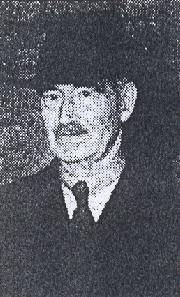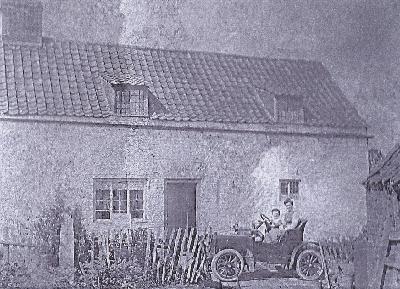|
Thomas
Whyment
Atkinson
1874-1954
|
 |
The town of Bourne can be thankful
to Alderman T W Atkinson for the Wellhead park and War Memorial gardens,
established in the years following the Second World War of 1939-45 with
money and property he bequeathed to the town.
Thomas Whyment Atkinson spent more than half a century devoted to farming
and the community, as union officer and advisor, councillor, alderman and
justice of the peace. He served for 52 years on Bourne Urban
District Council, subsequently joining South Kesteven
Rural District Council on its formation. He was also
a member of Kesteven County Council from 1910, being elevated to the aldermancy in 1921, and the following year was elected to the Kesteven
Standing Joint Committee.
His activities covered a wide range of interests with politics an
overwhelming motivation. As a staunch Conservative, he took an active role
in all general elections and was for a time vice-chairman of the Rutland
and Stamford Divisional Association. He was twice asked to allow his name
go forward as a Parliamentary candidate for the division, first at the
general election of 1922 and secondly at the by-election caused by the
death of the Conservative member, Mr Harvey Dixon. In addition, he was
invited to stand for the Holland with Boston division.
Apart from his public work, his predominant interest was farming and there
was little he did not know about agriculture. At one time, he farmed 3,222
acres in three counties, Rutland, Lincolnshire and Northamptonshire, and
was a well known breeder of Lincoln red Shorthorn cattle and Lincoln
Longwool sheep. He was also a keen horseman and for 40 years, while living
at Greatford, was in the habit of riding around his farm each morning
before breakfast. He eventually moved to Haconby Hall, near Bourne,
although for some years he also maintained a second residence, Windyridge
at Buxton in
Derbyshire.
Alderman Atkinson was also a keen farming administrator, anxious to pass
on his knowledge to others, and for four years was chairman of the Bourne
branch of the National Farmers’ Union. He was also involved with fen
drainage, being a member of the Black Sluice Commissions for 50 years and
chairman on several occasions as well as being chairman of the Haconby Fen
Drainage Board and serving on the boards for Bourne, Morton and Dunsby. In
1925, he was appointed by the Kesteven Agricultural Committee as its
representative on the Council of Agriculture for England and during both
world wars of the last century, from 1914-18 and 1939-45, served on the
Kesteven War Agricultural Committee, being the only member to have held
this distinction and he was not without military experience himself having
been commissioned as a subaltern in the Volunteer Battalion, the
Lincolnshire Regiment, during the Great War.
He was appointed a magistrate in October 1917, sitting on the Bourne
bench, and became chairman of the justices in March 1926, an appointment
he held until 1945, but only standing down then because he had reached the
compulsory retiring age of 75. For many years, he was a member of the
Board of Guardians at Bourne and when this body was superseded by the
Public Assistance Committee, he had the distinction of being chosen as the
first chairman of the new authority.
Alderman Atkinson was appointed chairman of Bourne Rural District Council
in 1922-23 and was the first chairman of the newly formed South Kesteven
Rural District Council. In 1927, he also became the first chairman of the
Bourne and district branch of the British Legion and held office until
1941. In 1945, another distinction came his way when he became High
Sheriff of Lincolnshire, an appointment he regarded as not only an honour
for himself but also for Kesteven and the Bourne area particularly.
He was also a keen motorist and ironically, it was this interest that
brought about his death. In 1903, he was involved in a serious accident
when he was then living at Greatford Manor but farming at Haconby. A local
newspaper reported on Monday 12th October that he was riding his machine
towards home when he overtook a party of men with dogs at Thurlby
crossroads. The report went on: "One of the dogs fouled the front wheel of
his motor with the result that he came down with great violence on to the
road. Bleeding and unconscious, he was taken to a neighbouring inn and
surgical assistance was summoned. When Dr John Gilpin arrived, he found Mr
Atkinson suffering from partial concussion of the brain."
He eventually recovered but his next serious accident near Bourne more
than 50 years later proved fatal. On 6th April 1954, his car hit the grass verge
and ran off the road at the junction of Mill Drove and Meadow Drove as he
was on his way home for lunch and the vehicle ended upside down in a
drainage dyke. A farmer, John James Dickinson, who was working in a field
nearby, saw the accident and rushed to the scene where he found the driver
pinned underneath the car almost covered with mud and water. He fetched
his tractor and some ropes and pulled the car clear as other helpers
arrived on the scene, his brother Edwin Dickinson and neighbouring farmers
Harry and Richard Ash, and between them, they went down into the dyke and supported
Alderman Atkinson
above the water until medical assistance arrived.
Two Bourne general practitioners, Dr George Holloway and Dr Cecil Sweetnam,
who arrived to give medical aid to the injured man, diagnosed his extensive injuries
which included a broken thigh and a large
scalp wound and he was rushed by ambulance to hospital in Peterborough
where a more detailed examination revealed a comminuted fracture of the
neck and severe shock. He underwent surgery but was discharged on July 1st
and sent home to convalesce but never fully recovered and after suffering miocardial degeneration, died on Thursday 9th December
at the age of 80. An inquest on
Friday 10th December recorded a verdict of accidental death and the deputy
coroner for Bourne, Mr Harry Ringrose, said: “Those at the scene did
everything they possibly could and I would like to thank these gentlemen
on behalf of the public for the manner in which they rendered that great
assistance.”
The funeral was held the following Monday at Haconby village church
attended by many relatives, friends, local councillors, public officials
and business associates. There were no flowers by request. Alderman
Atkinson had been married but his wife died in 1952 and there were no
children. In his will published in April 1956, he left £124,501 [almost £2
million in today's money] and there
were several bequests including property at Haconby to the trustees of
Bourne United Charities to enable the Wellhead field at Bourne be
developed as a park while the remainder of his estate, including Haconby
Hall and Hall Farm, was left in trust to his nephew, Joseph E Atkinson and
his family.
|
AN EARLY CAR OWNER
Thomas Atkinson was one of the first men in the
district to own a car, soon becoming a familiar sight out on the
road. But driving a car in the early days was fraught with
mechanical difficulties because it often broke down, as it had done
in this picture from circa 1920, when it was left in carpenter
Charles Whitelam's yard in Haconby Lane, giving Mrs Whitelam and her
son William the chance of a memorable photograph. |
 |
See also
The War Memorial
The Wellhead Gardens

Go to:
Main Index Villages
Index
|

